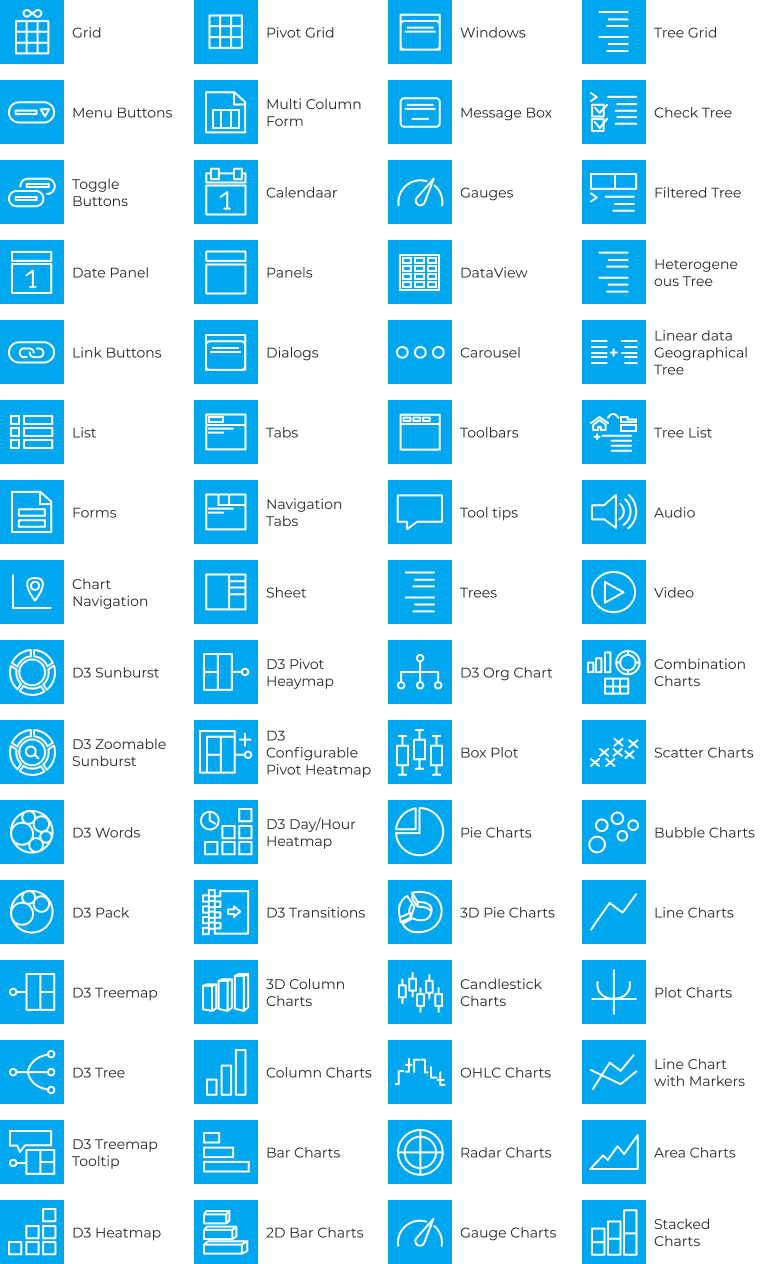Ext JS has been actively discussed among JavaScript communities over the last years. While some developers are vocal in advocating for Ext JS versatility, others are complaining about its sophisticated architecture.
What is Ext JS? What components does it include? What projects does it fit best?
This article answers these questions — and more. We discuss advantages and disadvantages of Ext JS and where it is used.
First, let’s unwrap what this abbreviation stands for.
1
What is Ext JS
Ext JS is a JavaScript framework that lets developers create web applications and user interfaces (UI) with cross-browser compatibility. This framework uses methods like Ajax, DHTML, and Document Object Model (DOM).
Ext JS represents a single platform supporting development of desktop and mobile applications. This framework is based on MVC/MVVM (The-Model-View-Controller, and Model View ViewModel, accordingly) architecture. This architecture is not mandatory, but it is highly recommended to comply with it.
Sticking to the suggested architecture makes your code well-structured, organized, and easy to maintain.
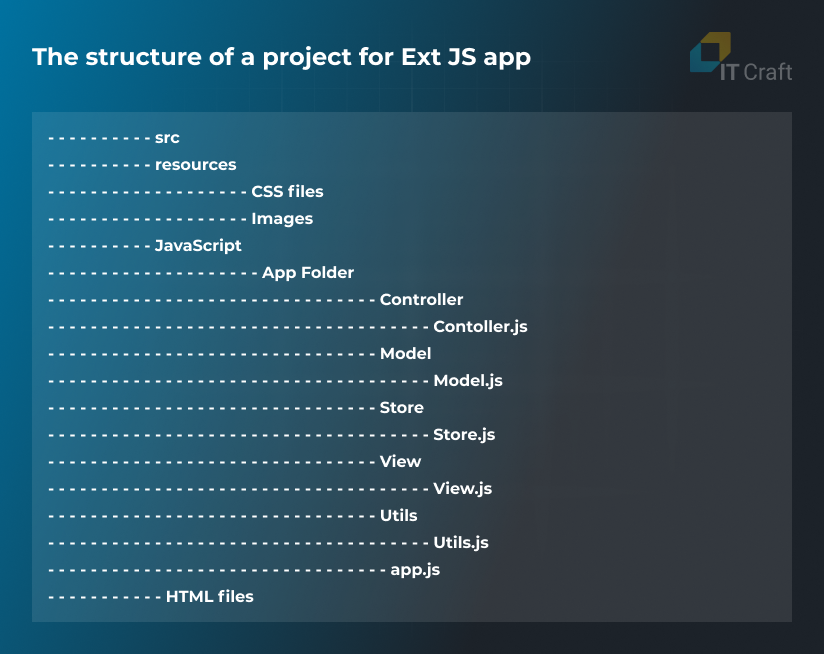
Ext JS app files are contained in your project JavaScript folder.
Ext JS helps developers organize and manage web application elements and perform accurate and efficient settings of such elements. The framework is also capable of separating application logic and its data from the visual part by adjusting the MVC template to web applications.
Ext JS works perfectly for creating both Single Page Applications and Rich Internet Applications. The framework delivers a rich (apologies for the tautology) interface that are:
- Interactive
- Stylized
- Usable
A comprehensive visual components library is one of the aspects ensuring such a sought-for UI. Let’s have a look at these components in more detail.
2
Ext JS components
Ext JS web application interface comprises widgets, known as components.
The components have a DOM data representation of objects. The lifecycle of each component includes the following three stages:
Initialization. Register the component with Ext.ComponentManager and define if rendering will take place.
Rendering. Build the DOM tree and add a component into the DOM hierarchy.
Destruction. Eliminate the DOM and unregister the component from Ext.ComponentManager.
Ext JS provides developers with the following essential advantages:
- Advanced components
- Easy-to-configure components
- All components are intercompatible
- Components are optimized for work with large datasets
- Extended package to process data
- Cross-platform support
- Architecture patterns
- Captivating themes
- Comprehensive tools:
- Ext JS Stencils — UI asset kit
- Sencha Architect — visual application builder
- Integrated development environment (IDE) plugins — app development facilitation tool
- Sencha Fiddle — Ext JS/ExtReact online service
- Sencha Themer — empowers app style
- Sencha Inspector — a debugging tool
- Sencha Test — robust unit and end-to-end tests
- Sencha Cmd — a command line tool that optimizes build process
- Sencha ext-gen — build optimization tool on a Node Package Manager basis
In the chart below, you can see the list of available UI components for Ext JS:
As we can see, the components library looks quite comprehensive. Of note: the components have subcomponents, thus developers can find many and varied options for their frontend routine.
As to the coding, Ext JS is a laconic-syntax framework. Let’s compare what it takes a developer to code a typical form component using Ext JS versus Angular:
FORM
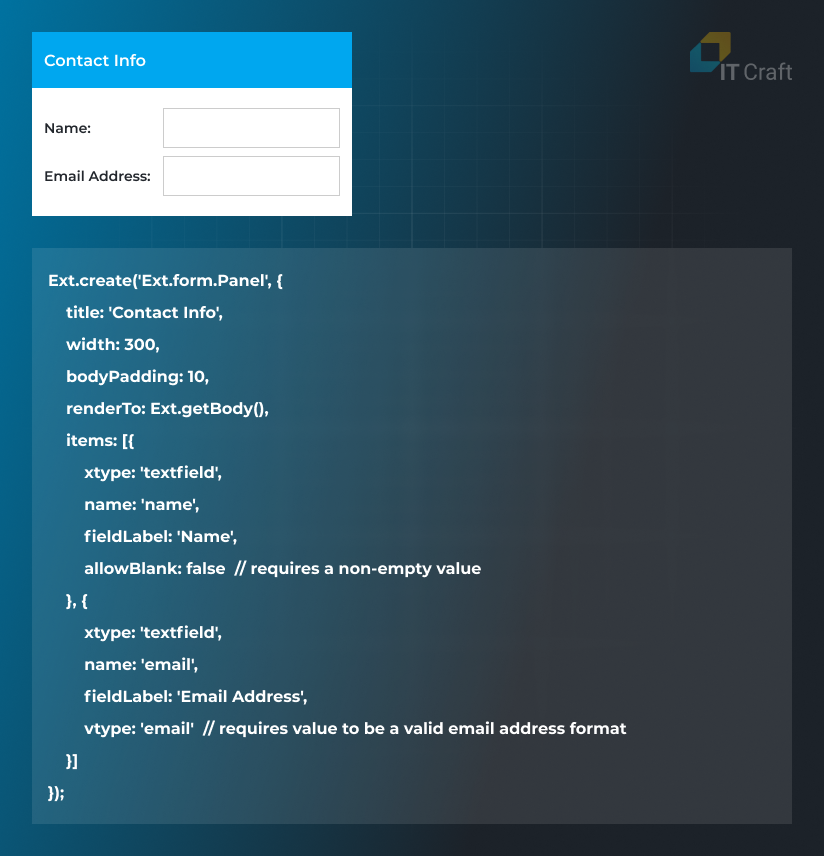
FORM
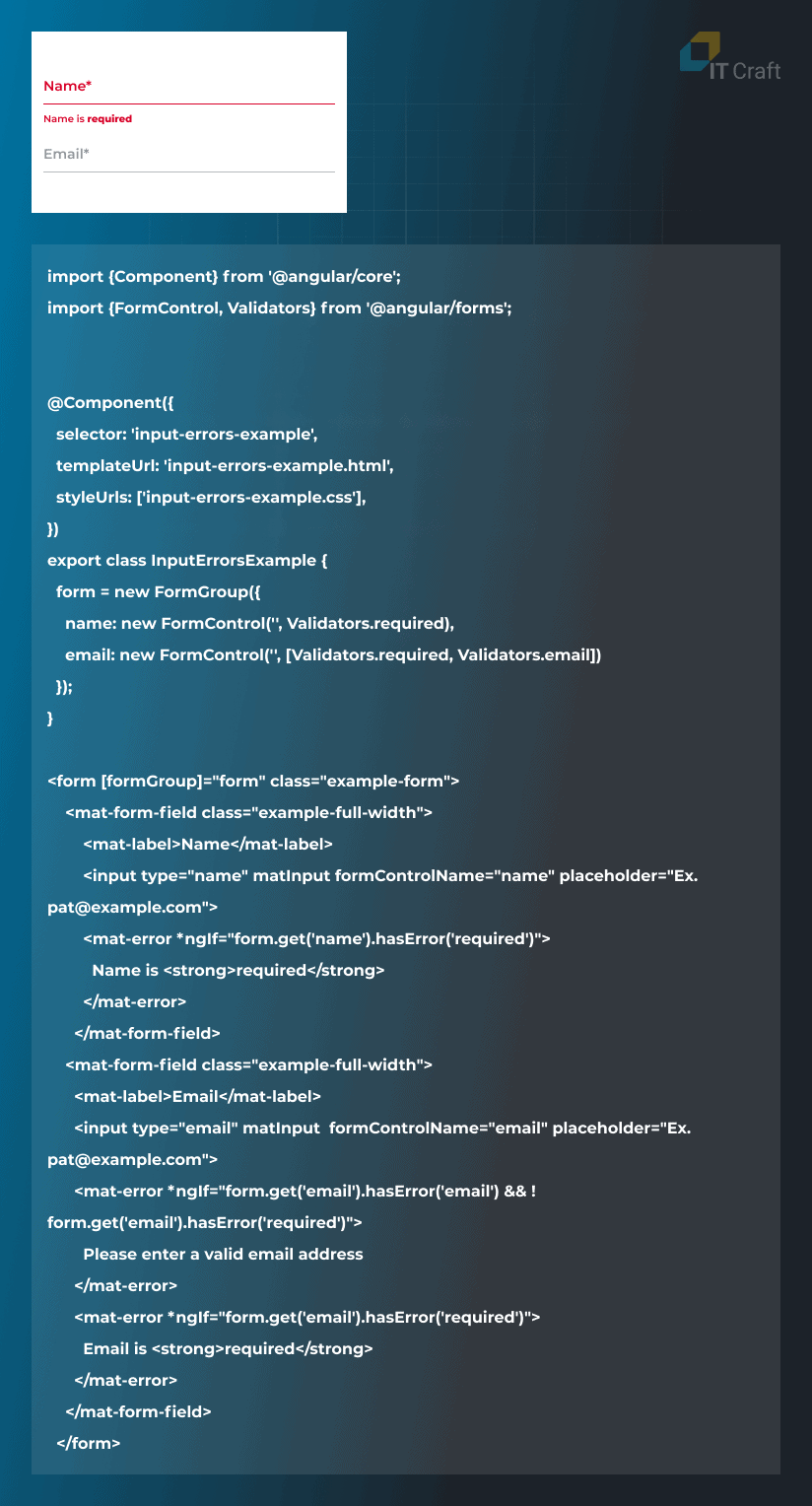
With Ext JS, we get the same functionality with half the code compared to the Angular framework. Plus, there is no need to work with HTML. Such a difference is extremely beneficial when it comes to the development of complex interfaces with a large number of components.
Now, having figured out what Ext JS is, let’s discuss where it is used.
3
Ext JS for enterprise web applications
Ext JS is designed for building data-intensive enterprise web applications. This framework shines best for applications that include multiple complex tables (which often can be found in enterprise-level projects). Creation of such complex tables is also possible in other frameworks (e.g., React, Angular), but it’s a real chore compared to Ext JS.
Simplification of the web app development process is achieved through an extensive component library almost eliminating the need for coding components on one’s own. Just take ready-made grids and tables and partially customize them, if necessary. The same works for templates. There are many to choose from, and you can tweak them to your needs. This significantly speeds up the development process.
Ext JS possesses one of the most versatile UI libraries in the industry. You can generate charts (column, bar, line, area, scatter, radial, and many others) in Canvas and in SVG. An enterprise web application can cover all its interface requirements due to Ext JS’s carousel, forms, trees, pivots, exporter, and other design assets.
Sencha Ext JS admin dashboard, the section for charts:
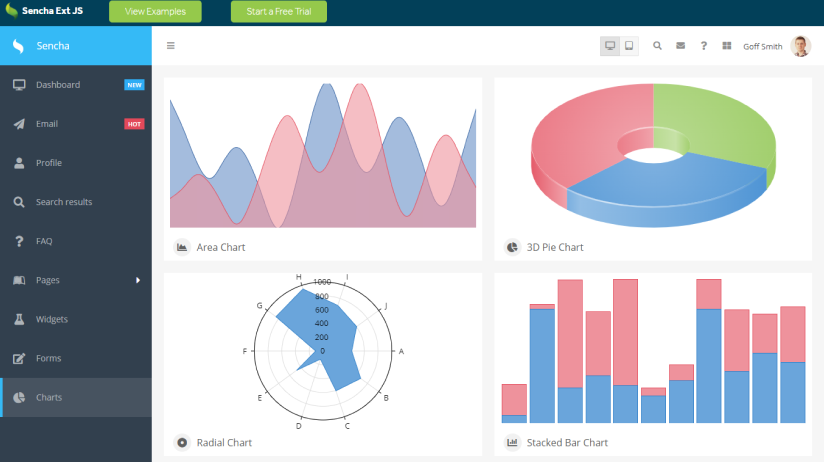 Source: https:///examples.sencha.com/extjs/7.6.0/examples/admin-dashboard/#charts
Source: https:///examples.sencha.com/extjs/7.6.0/examples/admin-dashboard/#charts
Area of use
Since the Ext JS framework ensures fast project delivery and reduces development costs, it is widely used for diverse business domains. Let’s have some examples of how the following industries can consume Ext JS graphic libraries:
- ERP (Enterprise Resource Planning). Trees components by Ext JS is a perfect tool for displaying hierarchical data in an application.
- CRM (Customer Relationship Management). Wherever there is a need to collect data from the user, try the Forms component.
- CMS (Content Management System). Picture and edit your web interface with Froala. Ext JS 7.x has a Premium code package for the Modern toolkit. The package lets you use the Froala WYSIWYG editor within your applications.
- E-Commerce. Carousels are excellent for users to swipe through e-catalogs.
- Logistics. Assigning shipment time and a date has never been so convenient and catchy as with the Calendar by Ext JS.
- FinTech. Need a chart to draw? Choose what you like: column, bar, line, area, scatter, financial, pie, radial, gauge, combination, and free-to-paint charts!
- HealthTech. The Pivot Grid component summarizes large sets of data. Collect and store massive records about patients in a structured and organized way with Pivot Grid.
The list goes on. The key to success is to find a reliable, experienced tech vendor.
Want to create a rich UI app? Our experienced team of designers can do it for you.
Let’s discuss your project!
Book a call now
4
What are the advantages and disadvantages of Ext JS?
Regarding Ext JS, some developers criticize it, arguing it is heavy, expensive, and glitchy. As a rule, most problems are related to improper environment configuration. When configured correctly and used with Sencha Cmd, a project with all its CSS and images will fill 1Mb in the production on average.
Check out the list of the framework’s essential advantages and disadvantages, so you can make a well-informed decision whether the pros outweigh the cons.
Ext JS pros:
- Versatility environment with an extensive package of components and templates
- Comprehensive technical documentation. You can find examples of code that you can configure and test
- Large community
- Integrated toolkits
- SAAS and Compass support
- Development costs reduction
- Optimization of cross-platform development for desktops, mobile, and web applications. Ext JS apps are compatible with old and up-to-date browser versions.
- Fits best for experienced developers
- Sophisticated architecture
- Knotty navigation. Not always easy to find a necessary class
- There can be errors in case of improper environment configuration
- The price might seem high ($1295 per single developer)
5
So what?
Comparing the advantages and disadvantages of the framework, we can conclude Ext JS is a time and money saver for enterprise-level projects. A speeded-up development process equals fewer billing hours. However, the challenge for businesses is finding advanced, highly qualified tech specialists to operate within this environment.
Ext JS supports configurable graphic elements for charts, forms, grids, and others. Thus, it is possible to calibrate existing fancy components precisely to the app interface requirements.
Technical documentation of Ext JS is far more extended and detailed compared to the other JavaScript frameworks. It includes examples of codes that can be changed and tested. Hence, developers can perform fast when using such code templates.
A large community of the framework is another prominent aspect. When bottlenecks happen—and they happen with everyone—developers can troubleshoot in topical forums. Or, if there is no such resolution, they can submit an issue. Other members of the community will help to figure it out. Collaboration is a superpower, you know.
IT Craft has 40 positive feedbacks on Clutch and is a top-rated tech provider on independent sources Upwork and GoodFirms.
!
The bottom line
Ext JS is one of the most feature-rich frameworks allowing businesses to create rich UI applications. It is designed for data-intensive enterprise web apps. Companies from different industries successfully release Ext JS’s potential. Although the price for the license is high, the fast development process eventually translates into money saved.

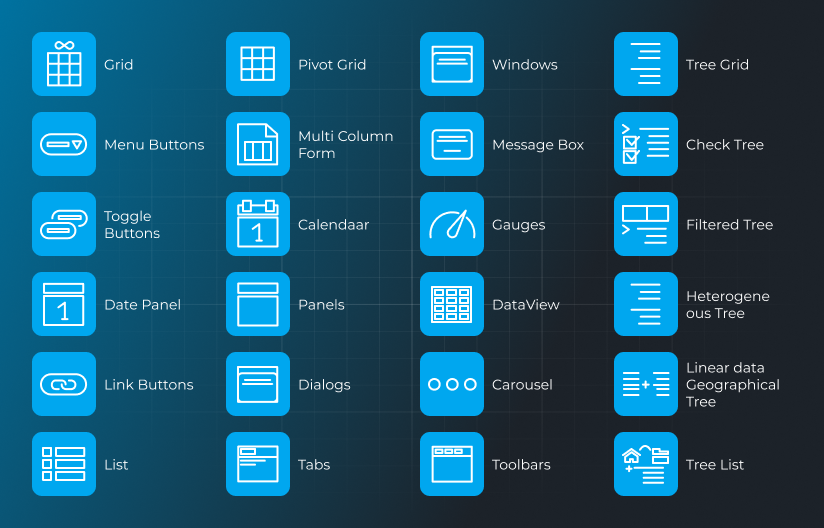
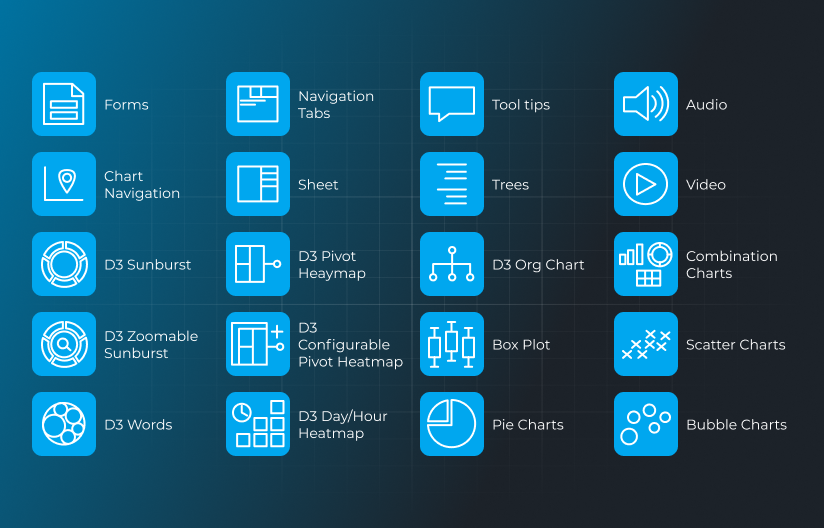
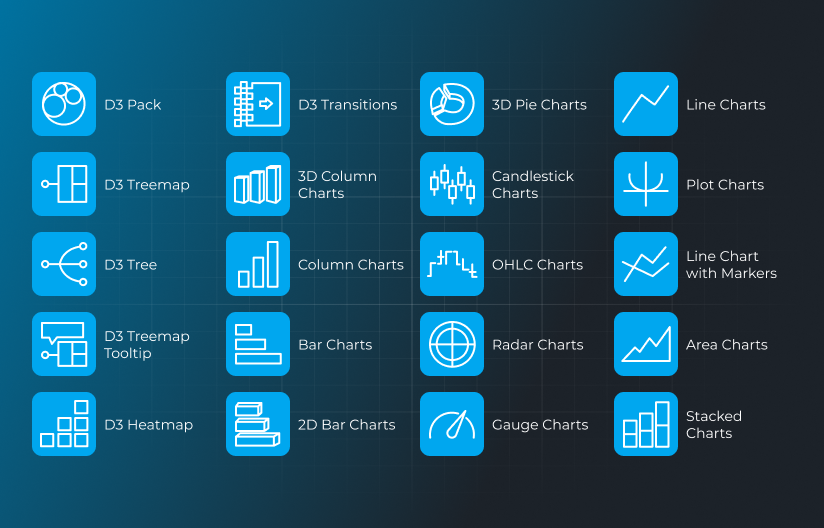


 Source: https:///examples.sencha.com/extjs/7.6.0/examples/admin-dashboard/#charts
Source: https:///examples.sencha.com/extjs/7.6.0/examples/admin-dashboard/#charts

